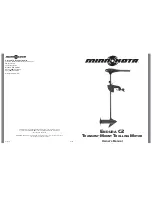
http://www.tyan.com
136
Bus:
a data pathway. The term is used especially to refer to the connection
between the processor and system memory, and between the processor and PCI or
ISA local buses.
Bus mastering:
allows peripheral devices and IDEs to access the system memory
without going through the CPU (similar to DMA channels).
Cache:
a temporary storage area for data that will be needed often by an
application. Using a cache lowers data access times since the information is stored
in SRAM instead of slower DRAM. Note that the cache is also much smaller than
your regular memory: a typical cache size is 512KB, while you may have as much
as 4GB of regular memory.
Closed and open jumpers:
jumpers and jumper pins are active when they are “on”
or “closed”, and inactive when they are “off” or “open”.
CMOS (Complementary Metal-Oxide Semiconductors):
chips that hold the basic
startup information for the BIOS.
COM port:
another name for the serial port, which is called as such because it
transmits the eight bits of a byte of data along one wire, and receives data on
another single wire (that is, the data is transmitted in serial form, one bit after
another). Parallel ports transmit the bits of a byte on eight different wires at the
same time (that is, in parallel form, eight bits at the same time).
DDR (Double Data Rate):
a technology designed to double the clock speed of the
memory. It activates output on both the rising and falling edge of the system clock
rather than on just the rising edge, potentially doubling output.
DIMM (Dual In-line Memory Module):
faster and more capacious form of RAM
than SIMMs, and do not need to be installed in pairs.
DIMM bank:
sometimes called DIMM socket because the physical slot and the
logical unit are the same. That is, one DIMM module fits into one DIMM socket,
which is capable of acting as a memory bank.
DMA (Direct Memory Access):
channels that are similar to IRQs. DMA channels
allow hardware devices (like soundcards or keyboards) to access the main memory
without involving the CPU. This frees up CPU resources for other tasks. As with
IRQs, it is vital that you do not double up devices on a single line. Plug-n-Play
devices will take care of this for you.
Содержание S5550
Страница 2: ...http www tyan com 2...
Страница 16: ...http www tyan com 16 NOTE...
Страница 19: ...http www tyan com 19 S5550AGM2NR EX...
Страница 20: ...http www tyan com 20 S5550GM4NR...
Страница 21: ...http www tyan com 21 S5550GM2NR...
Страница 22: ...http www tyan com 22 2 2 Block Diagram S5550 Block Diagram...
Страница 23: ...http www tyan com 23 2 3 Mainboard Mechanical Drawing...
Страница 34: ...http www tyan com 34 3 Secure the heat sink screws 4 Connect the fan cable to complete the installation...
Страница 37: ...http www tyan com 37...
Страница 68: ...http www tyan com 68 3 3 5 Server ME Configuration Server ME Configuration Read only...
Страница 85: ...http www tyan com 85 Wake system from S5 when set to Dynamic time Wake up minute increase Select 1 5 1...
Страница 86: ...http www tyan com 86 3 3 14 Super IO Configuration Super IO Chip Read only...
Страница 89: ...http www tyan com 89 3 3 15 1 Sensor Data Register Monitoring Read only...
Страница 109: ...http www tyan com 109 3 6 1 1 Restore Factory Keys Submenu Restore Factory Keys Press Yes to proceed No to cancel...
Страница 119: ...http www tyan com 119 3 7 4 Add New Boot Option Submenu Boot Option 1 Sets the system boot order Device Name Disabled...
Страница 132: ...http www tyan com 132 BIOS Temp Sensor Name Explanation...






































